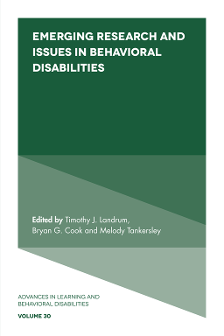
Index
Emerging Research and Issues in Behavioral Disabilities
ISBN: 978-1-78756-085-7, eISBN: 978-1-78756-084-0
ISSN: 0735-004X
Publication date: 30 November 2018
Citation
(2018), "Index", Emerging Research and Issues in Behavioral Disabilities (Advances in Learning and Behavioral Disabilities, Vol. 30), Emerald Publishing Limited, Leeds, pp. 161-169. https://doi.org/10.1108/S0735-004X20180000030011
Publisher
:Emerald Publishing Limited
Copyright © 2019 Emerald Publishing Limited
INDEX
- Prelims
- Emerging Research and Issues in Behavioral Disabilities: Incremental Progress and Introduction to the Volume
- Developing Direct Observation Systems to Measure Classroom Behavior for Students with Behavioral Disabilities
- A Generalizability Study of a Direct Observation Screening Tool of Teachers’ Classroom Management Skills
- Emerging Research and Development in Technology-based Self-monitoring
- Bullying and Students with Behavioral Disabilities: Examining the Intersection of Definition and Behaviors
- Behavioral, Academic, and Social Characteristics of Students with Behavioral Difficulties Served in a Residential Facility
- Positive Behavioral Interventions and Supports in Alternative Educational Placements
- Sources of Evidence-based Practice in EBD: Issues and Challenges
- Incorporating Function-based Support into Social Skills Interventions to Enhance Generalization
- Index